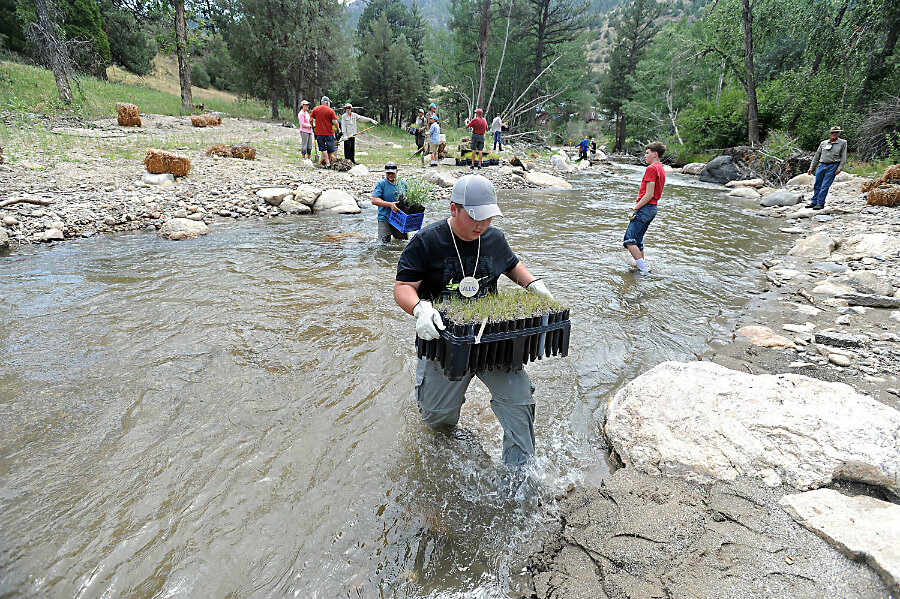Three years after damaging Colo. flood, teens help with river restoration
Loading...
| Drake, Colo.
Canyon resident Brendan Chenoweth described a two-year, $500,000 project to restore a flood-damaged portion of the North Fork of the Big Thompson River in Colorado as a gift – a way to return precious habitat along the river that so many people use and love.
The project, spearheaded by Wildlands Restoration Volunteers, is wrapping up, and a crew of teens attending a fly-fishing camp planted trees, shrubs and grass on a section of the river about 2 miles above Drake, Colo., as part of the final touches.
"It's really important," said Lina Spiller, a 14-year-old from Fort Collins, Colo., who attended the day camp put on by Rocky Mountain Flycasters, the local chapter of Trout Unlimited.
"We need to do all we can to conserve our wildlife so future generations can enjoy what we are (enjoying) and not just a dead landscape."
The Big Thompson River and the North Fork suffered severe damage during the September 2013 flood, reported the Loveland Reporter-Herald. Torrents of water wiped out homes, sheds, trees, boulders and anything else in their path and left behind destruction that, in many places, resembled a barren moonscape.
That is how Chenoweth described his family's Opal Ranch, through which the North Fork runs.
He said after the flood, the Chenoweth family removed 1,400 dump-truck loads of debris, burning out about three trucks, and worked on putting the river channel back into place.
But the amount of work they still face would be so much more without this restoration project, which will improve the river health all around.
"It took that river restoration that I thought would take the next 20 years of my life and got it done," Chenoweth said, explaining how many people have left a permanent positive mark on the landscape with their volunteer hours.
"It's a gift."
During the aftermath of the flood, Wildland Restoration Volunteers began reaching out to find ways to help restore trails, wildlands and sections of the river.
They connected with Chenoweth and other landowners and applied for state grants to redesign and rehabilitate a 2.5-mile section of the North Fork to be studied and used as an example for future projects. Most of the land in the project is owned by the Chenoweth family and Colorado Parks and Wildlife.
With $360,000 in grants and $140,000 worth of donated time and supplies, crews and volunteers have realigned and regraded the river channel to make the river and surrounding habitat healthy and more able to survive a future flood.
This included specifically designing the depth of pools in the river, carefully placing rocks to create ripples in the water and to stabilize the bank and creating areas along the river that will allow water to slow down and spread out in the event of another flood.
The next step was to plant vegetation along the river to enhance habitat and to protect the banks from erosion.
The teens from the Rocky Mountain Flycasters Fly Fishing Conservation Camp worked on the planting several weeks ago, putting in willows, cottonwoods, dogwoods, chokecherry trees and native grasses.
Luke McNally, who works for Wildlands Restoration Volunteers, pointed out to the teens the trees that survived the flood as well as grasses that have returned since. But, he noted, the amount of plant life is nothing compared with what was there before the flood.
"That's why we're here today – to put some of that vegetation back," McNally said.
The students were excited to get their hands in the dirt and on shovels, to wade through the river and to make a difference to the landscape they love.
"It's just really great we can do this and help out in some way," said Jakob Borrman, a 14-year-old from Loveland, Colo., as he began digging holes for young trees.
Nearby, Zach Balliew and Dallas Padron, both 15-year-olds from Loveland, began hauling supplies to plant native grasses across the North Fork.
"We've got to keep the river flowing," said Zach. "We've got to keep all the vegetation around it so we have the river and have fish."
The goal of the camp, which is in its seventh year, is for the teens to learn about fishing as well as ecology and conservation and to stir in them a love of the outdoors and a desire to protect the lands, noted Dennis Cook, camp director and a member of Rocky Mountain Flycasters.
He added, "We want them to take away a respect for (the outdoors) and a valuable ethic that this is important."







